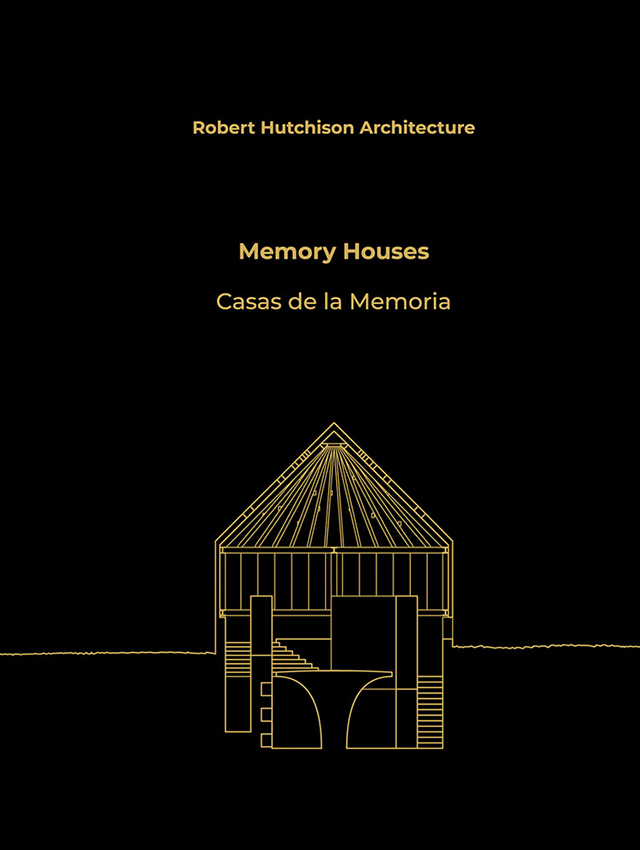Memory Houses
Memory HousesRobert Hutchison ArchitectureArquine, March 2020Hardcover | 7 x 9-1/2 inches | 152 pages | 90 illustrations | English/Spanish | ISBN: 978-6079489526 | $32.00PUBLISHER'S DESCRIPTION: Seattle-based architect Robert Hutchison’s Memory Houses is a project that investigates mortality and memory through the lens of architecture. Speculatively situated along the banks of the Wye River on the Eastern Shore of Maryland where the architect grew up, architectural typologies such as dwelling, chapel, lighthouse and memorial weave together a spatial narrative about loss and recollection. Distant as well as more recent architectural memories make cameo appearances in the memory houses: the stave churches of Norway and the Great Mosque of Córdoba that Hutchison experienced as a child; the lighthouses of the Chesapeake Bay; the timber grain elevators of the Palouse; the Colosseum and the Santo Stefano Rotondo in Rome. This publication, with a hot-stamped cover and end sheets printed with Hutchinson’s designs, documents the eight buildings that comprise the Memory Houses project, alongside built houses designed by Hutchison’s Seattle-based firm Robert Hutchison Architecture. Robert Hutchison is a practitioner, researcher, and educator whose interests and practice overlap the fields of architecture, art and photography. ... After working for the Miller|Hull Partnership and serving as a principal of Hutchison & Maul Architecture, Hutchison established the architecture studio Robert Hutchison Architecture. REFERRAL LINKS: dDAB COMMENTARY: Looking through the designs by Seattle architect Robert Hutchison that are collected in Memory Houses, I can't help but think of Douglas Darden, whose only monograph, Condemned Building, was released three years before he died from leukemia at 43 years of age. Just as Darden's beautifully delineated projects — all of them unbuilt — were centered around his impending death, the main projects in Hutchison's book were sparked by the dementia that took over his father's mind and eventually his life. Hutchison's House for Remains, for example, recalls such Darden projects as Oxygen House (the end-of-life house was designed for a fictional person who was clearly a surrogate for Darden) in terms of both a poetic tone and an architectural expression to match. Although Hutchison's line drawings and computer renderings won't be mistaken for Darden's lushly shaded drawings, the moody images in Memory Houses are very appealing, a refreshing antidote to hyper-realistic renderings and other trendy architectural images. The beautifully crafted hardcover book contains sixteen houses by Hutchison's eponymous firm: eight of them built and eight of them unbuilt. These built and unbuilt projects alternate throughout the book; the former are presented with primarily black-and-white photos, a tactic that makes them seamlessly meld with the desaturated renderings of the latter. The eight unbuilt "memory houses" — the book's raison d'être — are located on a waterfront site in Maryland, on land that Hutchison's parents owned when he was a young architect but had sold by the time of his father's dementia. Sited in a line from northeast to southwest (first spread below), the projects comprise an architectural exploration of a poetic path: across space and time, the latter culminating in death. A highlight of these projects is the House for Locomotives, a nautilus-shaped building (seen in the other spreads below) that picks up on the existence of a railroad spur accessing the site while also referring to a domed church in Rome. The latter brings us to Hutchison's year spent at the American Academy in Rome a year after his father died. He acknowledges the time at the Academy as "critical to the development and resolution of this project." In Rome he honed his interests in geometry and architectural typologies, in particular "how one might 'sample' and collage them to create new architectures." These words again echo Darden, who developed the forms for his projects by layering seemingly disconnected images atop each other. Hutchison's projects — built and unbuilt, temporary and permanent — are more platonic, using gables, cylinders, and other forms to explore function through familiar forms. Writing that sentence makes me also think of Aldo Rossi, whose theories of memory and typology preferred such architectural forms. But ultimately Hutchison's architecture is his own, suffused with these and other influential voices but staking out a position that is as personal as it is poetic. SPREADS:

Arquine, March 2020
Hardcover | 7 x 9-1/2 inches | 152 pages | 90 illustrations | English/Spanish | ISBN: 978-6079489526 | $32.00
PUBLISHER'S DESCRIPTION:
REFERRAL LINKS:
SPREADS:










